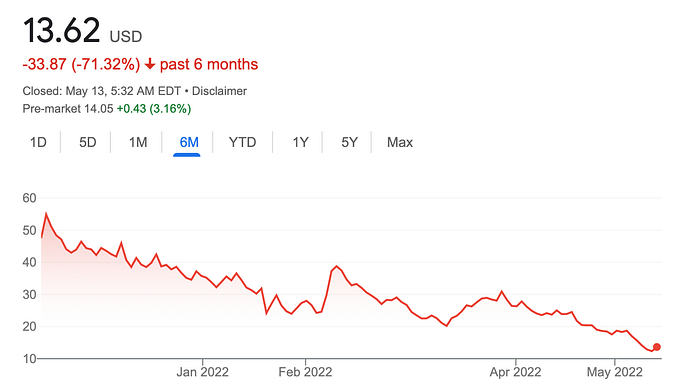

Peloton Is Spinning Out of Control
source link: https://stephenmoore.medium.com/peloton-is-spinning-out-of-control-254154287e7a
Go to the source link to view the article. You can view the picture content, updated content and better typesetting reading experience. If the link is broken, please click the button below to view the snapshot at that time.
Peloton Is Spinning Out of Control
The company’s stock price just hit an all-time low

Motivation That Moves You.
On May 9, Peloton unveiled a brand refresh, including a new campaign featuring its most popular instructors and a first-ever tagline.
While the tagline will do little to motivate users into fitness — a constant human struggle that takes more than flashy advertising — it certainly motivated the stock price.
The day after the reveal, Peloton shares hit an all-time low of $12.34.
The story aptly sums up the struggles of a company that, despite managing to appeal to large amounts of high-earnings users, cementing its place in pop culture, and enjoying unprecedented gains thanks to the repercussions of the pandemic, has still managed to implode. During its pandemic-induced boom, Peloton’s shares were priced at over $160, and its market cap rose to a staggering $47 billion. That market cap now sits at $4.52 billion.
Ouch.

The numbers make grimmer reading than the lack of calories burned on the bikes. The stock is down
- 85% in the past year
- 70% in the last 6 months
- 45% in the last month
- 18% in the last five days
Many factors have driven the decline, which has been picking up speed since Sept 2021. It started with the treadmill recall after they were linked to the death of a user, which cost the company $165 million and far more in reputational damage. Then, the world began to return to ‘normal,’ and indoor, in-person gyms once again opened their doors. The company’s churn rate tripled, losses piled up, and subscriber growth forecasts were cut left, right and center. Competitors like Planet Fitness — an in-person gym — quickly recaptured most of their pre-covid memberships, pulling members away from Peloton. (At the time of writing, Planet Fitness’s share price is $50 a share.) Then came the news that the company had warehouses filled with stock and a lack of bedrooms looking for a large item to gather dust. The announcement to pull back on production caused the stock price to drop 24% — back to the pre-public offering price of $29.
4 months later, little has improved.
In its first earnings call under new CEO Barry McCarthy, the bad news kept coming. After spending the last few months digging through the company’s dirty laundry, he admitted that he was surprised to discover Peloton is “weaker on everything supply chain” and struggling with cash flow. Other bad news included,
- Revenue fell 24 percent from last year, down to $964.3 million (from $1.26 billion), compared to losses of $757.1 million.
- Membership only increased by 5%
- There were also $30 million of write-downs covering inventory that the company is struggling to sell.
Even the good news was tempered: the churn rate had decreased to 0.75%, but with subscription price hikes on the way, it’s expected to rise again. More worryingly, Peloton’s outlook for its current quarter, which ends on June 30, was bleak. Not surprisingly, the far-from-positive earnings call resulted in more damage to the stock price, which fell to its lowest ever price. Even less surprising is the news of the company’s refreshed brand went almost entirely unnoticed.
So, what’s next?
McCarthy is under no illusions, stating that “turnarounds take time.” But the bigger question is, can this even be turned around? Despite plans to be more aggressive in international markets and build more relationships with third-party sellers, the overall strategy lacks anything that will give investors confidence.
McCarthy spoke of focusing more on the app and producing more content to get users to sign up without the need for a Peloton device. The company will also continue trialing a scheme that allows users to pay a flat rate to borrow a device and the subscription but gives them the option to return it.
But with the company still harboring ambitions of growing to 100 million subscribers, will an app community drive the needle? With the current number of subscribers sitting at 7 million, it seems like a pipe dream.
Where do the other 93 million come from? The only answer to that is the same one that’s been evident since the pandemic subsided — acquisition. Nike, Amazon, Apple, maybe even LuluLemon, must be circling Peloton’s slowly dying carcass like hungry vultures, waiting to pick it off when the wheels finally fall off. And at the current price, it’s a steal. The buyer gets direct access to a category of rich, healthy users who have disposable income, are happy to pay a subscription for convenience, and are highly engaged with an ecosystem that could easily be incorporated into the buyer’s own. It’s a no-brainer.
The story has been a rollercoaster to date, and it’s likely still got legs left. But, in some ways, Peloton has already won the race.
It just happens to be the wrong one: the race to the bottom.
If you want to read more of my work, or the work of the many, many great writers on this platform, consider becoming a member. Your membership fee directly supports the writers you read. If you sign up using my link, I’ll earn a small commission. Appreciate you.
Recommend
About Joyk
Aggregate valuable and interesting links.
Joyk means Joy of geeK